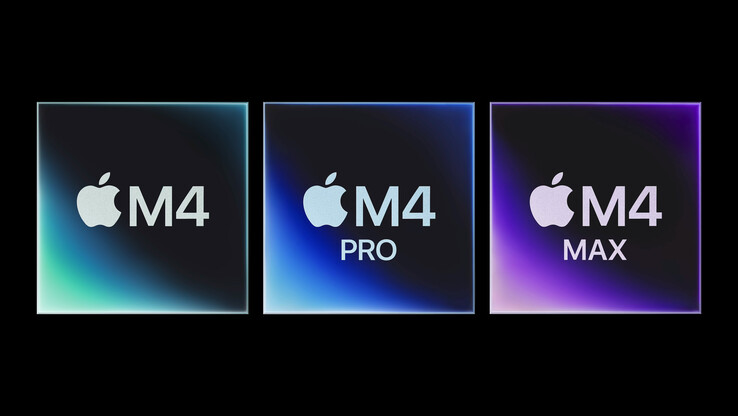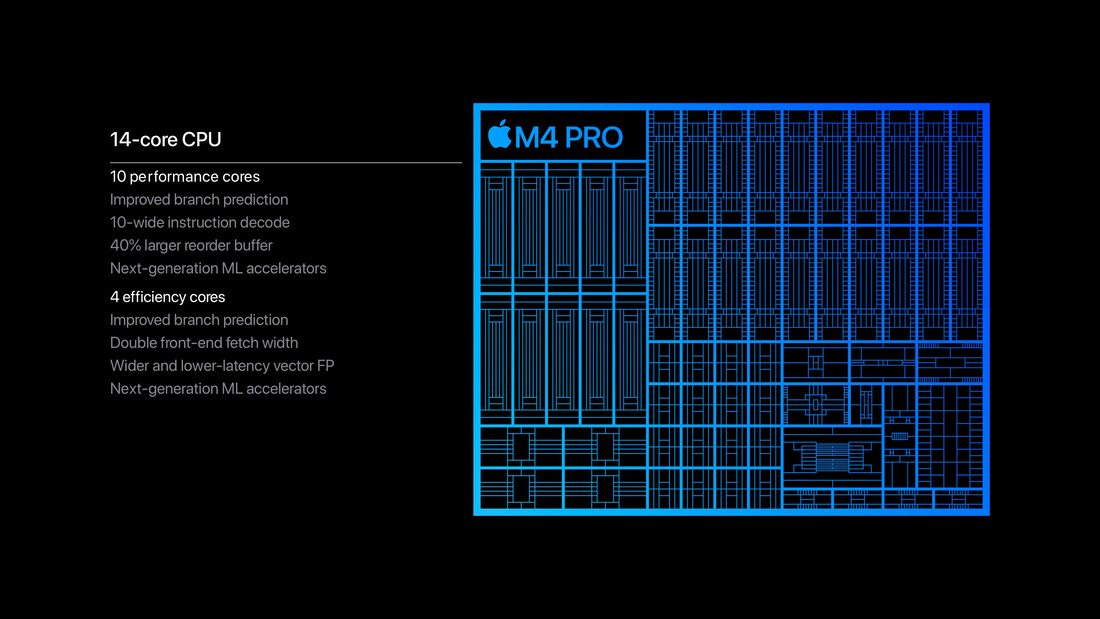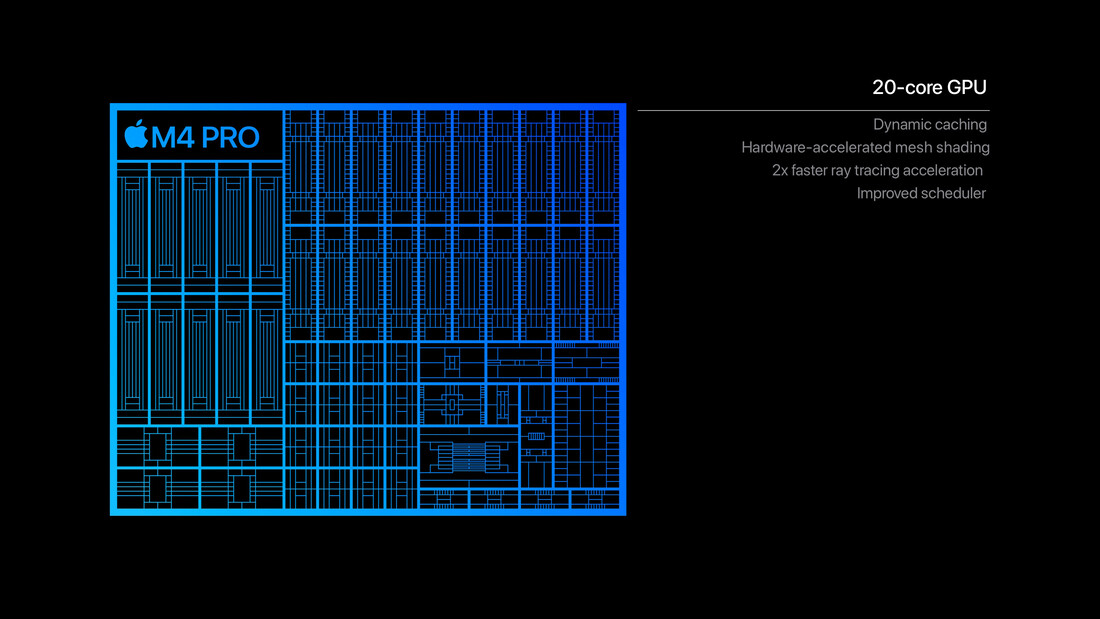Apple M4 Pro analysis - Extremely fast, but not as efficient
Apple surprisingly already presented its newest M4 chip generation several months ago inside the latest iPad Pro. Its single-core performance proved to be especially impressive for such a frugal chip that is cooled passively. Shortly before the launch of Qualcomm's Snapdragon X Elite processors, Apple managed to take some of the wind out of the competition's sails. Now, the latest chip generation has finally made it into the updated MacBooks. It seems that the Air models will have to wait until the beginning of next year, but the Pro laptops now come equipped with the M4, M4 Pro and M4 Max. At their market launch, we were able to take a look at the new M4 Pro in its full configuration (14 CPU cores, 20 GPU cores) and will shortly be adding results for the smaller M4 Pro and the M4 Max.
Overview Apple M4 Pro
The core configuration of the new M4 Pro SoC differs a lot compared to its predecessors and from a performance perspective, Apple has brought its Pro and Max models closer together again (at least on the CPU side). Instead of six efficiency cores, all variants (M4 Pro & M4 Max) now only feature four efficiency cores that only reach up to 2.592 GHz (previously 2.748 GHz).
In addition, there are now two clusters with five performance cores, whereby only four are active in the entry-level M4 Pro. The P-cores can reach a clock rate of up to 4.512 GHz and 3.852 GHz on all cores (previously 4.056 Ghz at most for one core and approx. ~3.6 GHz with all cores under load). This means the M4 Pro has 14 or 16 CPU cores in total. We also noted a conceptual change in this respect, as there is now a variant of both the M4 Pro and the M4 Max with 14 CPU cores (M4 Max optionally with 16 CPU cores).
The M4 Pro continues to be manufactured using a 3-nm process and on the old M3 Pro (27-28 watts), we measured a lower consumption than on the M2 Pro models (~36 watts), despite its improved performance. In contrast, Apple has now raised its maximum power consumption a lot. Under full multi-core load, the new M4 Pro can consume up to 46 watts, settling at around 40 watts during the further course—so at its peak, it consumes 60% more. With one core under load, its power consumption is around 6-6.5 watts; on the M3 Pro, we measured ~5.5 watts.
Inside the MacBook Pro models, the M4 Pro comes with either 24 or 48 GB RAM. In the new Mac Mini, the M4 Pro can additionally be combined with 64 GB, as you can't get the Mac Mini with the M4 Max. If you need more than 48 GB RAM in the new MBP, then you'll have to go for the M4 Max (max. 128 GB RAM). Apple has raised the memory bandwidth from 150 GB/s on the M3 Pro (LPDDR5-6400) to 273 GB/s on the M4 Pro (LPDDR5x-8533).
Both of the M4 Pro models also show some differences in their integrated graphics cards. The base variant features a GPU with 16 cores and the faster model has a GPU with 20 cores. During our test, the top-of-the-range model showed a maximum consumption of 32 watts compared to the 28 watts we measured on the M3 Pro GPU with 18 cores. As always, we couldn't read out the GPUs' clock rates. The two M4 Max GPUs are each equipped with double the amount of GPU cores (32 or 40).
There have been further improvements made to the Neural Engine and Apple is currently also heavily promoting its version of an AI called Apple Intelligence, which is supported by all M4 chips. Another interesting innovation relates to the M4, as the M4 SoCs inside the MacBook Pro models have Thunderbolt 4 support and an improved display engine, which now allows two external displays to be connected (in addition to the internal panel). In all likelihood, this will also be the case in the upcoming MacBook Air models. The following table summarizes the most important technical data of the new M4 SoC generation:
| M4 | M4 Pro | M4 Pro | M4 Max | M4 Max | |
|---|---|---|---|---|---|
| CPU | 10 cores (4P+6E) | 12 cores (8P+4E) | 14 cores (10P+4E) | 14 cores (10P+4E) | 16 cores (12P+4E) |
| GPU | 10 cores | 16 cores | 20 cores | 32 cores | 40 cores |
| RAM | 16/24/32 GB | 24/48 GB | 24/48 GB | 36 GB | 48/64/128 GB |
| Memory bandwidth | 120 GB/s | 273 GB/s | 273 GB/s | 410 GB/s | 546 GB/s |
core-to-core-lantency M4 Pro 12 Core
| Core 0 | Core 1 | Core 2 | Core 3 | Core 4 | Core 5 | Core 6 | Core 7 | Core 8 | Core 9 | Core 10 | Core 11 | |
|---|---|---|---|---|---|---|---|---|---|---|---|---|
| Core 0 | ||||||||||||
| Core 1 | 37.5 | |||||||||||
| Core 2 | 34.8 | 35.4 | ||||||||||
| Core 3 | 32.8 | 34.2 | 34.6 | |||||||||
| Core 4 | 34.7 | 33.9 | 34.8 | 34.7 | ||||||||
| Core 5 | 31.7 | 34.8 | 34.7 | 33.8 | 35.1 | |||||||
| Core 6 | 30.8 | 32.3 | 34.3 | 33.2 | 34.3 | 32.5 | ||||||
| Core 7 | 29.9 | 34.8 | 32.9 | 34.4 | 35.3 | 29.7 | 34.4 | |||||
| Core 8 | 35.3 | 30.1 | 33 | 30.2 | 30 | 34.7 | 33 | 32 | ||||
| Core 9 | 32 | 32 | 33.8 | 33.5 | 28.9 | 32.2 | 33.6 | 29.3 | 34.4 | |||
| Core 10 | 34.7 | 30.1 | 34.7 | 34.2 | 34.6 | 34.4 | 31.8 | 34.8 | 35 | 34.9 | ||
| Core 11 | 34.9 | 33.8 | 34.5 | 30.5 | 34 | 34.7 | 35.4 | 34.8 | 34.4 | 30.9 | 35.2 |
Test procedure
In order to make a meaningful comparison between the different processors and graphics cards, we took a look at their power consumption in addition to their pure performance during synthetic benchmarks, from which we then determined their efficiency. Our consumption measurements are always carried out on an external display so that we can eliminate the different internal displays as influencing factors. Nevertheless, we measured the overall consumption of the system and didn't just rely on the displayed values for the CPU and GPU, which is why the different chip sizes (including more RAM etc.) naturally also play a role. This is particularly important for our MacBook Pro 14 test device, as it is equipped with 48 GB of RAM and will inevitably consume more power than a model with 24 GB or 18 GB of RAM like the old M3 Pro.
Single-core performance & efficiency
The M3 generation already offered extremely good single-core performance, leaving the competition from AMD, Intel and Qualcomm in the dust. Only Intel's new desktop processor, the Core Ultra 9 285K, was on a comparable level to the M3 SoCs. Apple has stepped up its game even more with its new M4 processors, further widening the gap massively. The P-cores' maximum clock rate, which is about 500 Mhz higher, results in a performance boost of over 20% compared to the M3 models.
Its advantage over the next fastest mobile chip, the Snapdragon X Elite X1E-84-100—which is currently only available in the Samsung Galaxy Book4 Edge 16—is almost 40%. The current CPUs from AMD and Intel have an even greater disadvantage.
When analyzing efficiency, we primarily relied on the current Cinebench 2024 test, which runs natively on all platforms (x86 & ARM) and therefore offers us the best opportunity for comparison. However, our measured values are limited, which is why we also made use of the older Cinebench R23 test.
When it came to single-core efficiency, the new M4 Pro fell behind most M3 devices, although the processor's additional consumption was easily compensated for by its performance gain. However, since we are talking about very low CPU core consumption values (maximum 6.5 watts), other factors such as the additional RAM may distort the picture somewhat. At this point, we are already looking forward to what the base M4 Pro with 24 GB RAM delivers—as well as the regular M4 with 16 GB RAM. Even so, all other mobile processors (including Lunar Lake, Snapdragon X Elite/Plus, Zen5) were still clearly beaten in terms of efficiency, despite their significantly lower performance.
| Power Consumption / Cinebench 2024 Single Power Efficiency - external Monitor | |
| Apple M3 | |
| Apple M4 Pro (14 cores) | |
| Apple M4 Pro (12 cores) | |
| Qualcomm Snapdragon X Plus X1P-42-100 | |
| Qualcomm Snapdragon X Elite X1E-78-100 | |
| Qualcomm Snapdragon X Elite X1E-84-100 | |
| Intel Core Ultra 7 258V | |
| Intel Core Ultra 5 125U | |
| AMD Ryzen AI 9 365 | |
| AMD Ryzen AI 9 HX 370 | |
| Intel Core Ultra 7 155H | |
Multi-core performance & efficiency
Its results in the multi-core tests were even greater than its lead in the single-core tests, which is due to the processor's increased number of performance cores as well as its higher clock rate. Depending on the test, its lead over the old M3 Pro with 12 cores was between 47-57% and, as a result, the new M4 Pro is on par with the old full M3 Max. This is a considerable increase in performance and, especially within the 14-inch field, the new M4 Pro faces no competition—neither from AMD, Qualcomm nor Intel. The only exception in this case is the Ryzen AI 9 HX370 inside the Asus TUF A14, which can permanently consume 80 watts and performed slightly better in the CB-R23 test. However, it fell significantly behind the M4 Pro during both the Cinebench 2024 and Geekbench tests.
In terms of efficiency, the M4 Pro's increased consumption is of course noticeable—this was especially true during the relatively short R23 test. Here, the new M4 Pro fell behind the M3 predecessor models and also individual models of the Ryzen AI 9 HX 370. In the longer Cinebench 2024 benchmark, it couldn't maintain its high power consumption of 46 watts the entire time, which is why it at least overtook the AMD SoC. However, the new M4 Pro only showed a marginal advantage compared to Qualcomm's ARM CPUs. We have no comparative data for the old M3 Pro models for the 2024 test.
GPU performance & efficiency
Its GPU performance has also been significantly increased and, depending on the benchmark, the advantage of the new M4 Pro GPU with 20 cores lay between 29-45% compared to the old M3 Pro GPU with 18 cores. However, the new M4 Pro couldn't come close to the M3 Max GPU and instead maintained a respectful distance. The integrated graphics cards from AMD, Intel or Qualcomm were no competition for the M4 Pro and already struggled to keep up with the normal M4 GPU in the iPad Pro. In this case, we had to compare it with dedicated GPUs, whereby the M4 Pro GPU was generally on par with a GeForce RTX 4060 Laptop.
Cinebench 2024: GPU
Geekbench 6.5: GPU Metal | GPU OpenCL
GFXBench: 3840x2160 4K Aztec Ruins High Tier Offscreen | 2560x1440 Aztec Ruins High Tier Offscreen
| Geekbench 6.5 / GPU Metal | |
| Apple M3 Max 40-Core GPU | |
| Apple M4 Pro 20-Core GPU | |
| Apple M4 Pro 16-Core GPU | |
| Apple M3 Pro 18-Core GPU | |
| Apple M3 Pro 14-Core GPU | |
| Apple M4 10-core GPU | |
| Apple M3 10-Core GPU | |
Cinebench 2024: GPU
Geekbench 6.5: GPU Metal | GPU OpenCL
GFXBench: 3840x2160 4K Aztec Ruins High Tier Offscreen | 2560x1440 Aztec Ruins High Tier Offscreen
We also wanted to take a look at the GPU's efficiency when gaming. However, you have to bear in mind that the two games we used—The Witcher 3 and Cyberpunk 2077—are only emulated on the MacBook Pro, which naturally comes at the cost of some performance. A real comparison will be possible next year when Cyberpunk 2077 is released natively for Apple processors.
In the Witcher 3 test, its efficiency was slightly worse compared to the old M3 chips, but it still beat the other manufacturers (albeit sometimes very narrowly). In the Cyberpunk 2077 test, the M4 Pro SoC also only just came ahead of the competition. The new Intel Arc Graphics 140V (Lunar Lake) was significantly more efficient in this scenario but also offered significantly lower performance.
Verdict - The M4 Pro has become significantly faster, but not more efficient
The M4 SoC family is Apple's second processor generation to be manufactured using a 3-nm process. After significantly improving efficiency in particular with its M3 Pro series (slightly more performance with less power consumption), Apple has now focused on improving performance more than anything with its new M4 Pro models. Its single-core performance (+20% compared to M3) is simply impressive and leaves every other processor (whether desktop or mobile) far behind—and the competition doesn't stand a chance when it comes to efficiency, either. In comparison with the old M3 Pro, its efficiency is slightly worse, but the significantly higher RAM configuration could very well have an influence here. We are therefore curious to see how the small M4 Pro and the regular M4 will perform. We will provide these results as soon as possible.
Impressive CPU & GPU performance: The new Apple M4 Pro SoC is by far the fastest single-core processor and is on par with the old M3 Max in multi-core scenarios. There exists no competition from AMD, Intel or Qualcomm within the 14-inch segment. Its GPU performance is also more than 30% better. However, this increase in performance comes somewhat at the expense of efficiency.
In terms of multi-core performance, its increase in performance is similarly enormous and the new M4 Pro can compete with the old full version of the M3 Max. Plus, its advantage over the old M3 Pro is 45-59% (depending on the test). Compared to the old M3 Pro, however, its maximum consumption is also up to 60% higher, which is why not much has changed in terms of efficiency. Especially within the 14-inch segment, the Apple M4 Pro faces no competition from Intel or AMD when it comes to CPU performance. In the 16-inch range, there are the HX processors—but they also consume significantly more power.
Its graphics performance has also been significantly increased, as depending on the benchmark, we determined a lead of 29-46% compared to the old M3 Pro GPU. However, there is still a clear difference compared to the M3 Max GPU.









